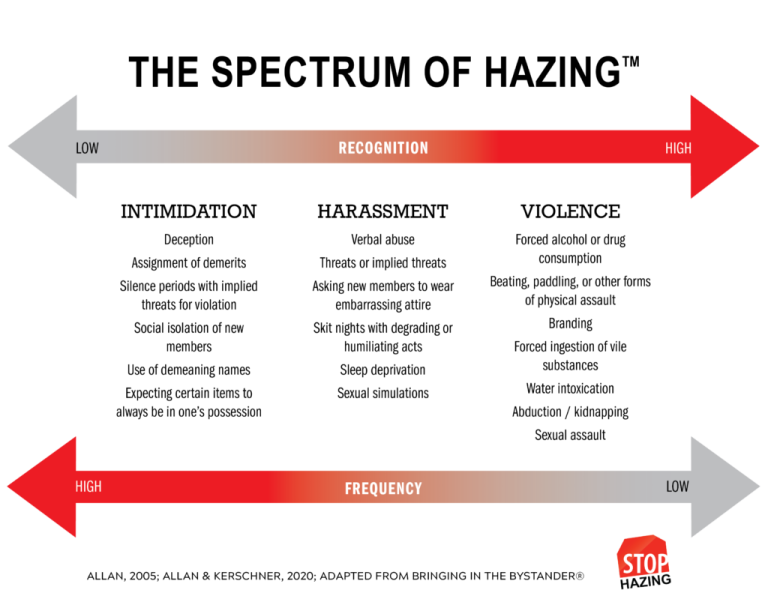Hazing is any intentional, knowing, or reckless act against an individual that endangers the physical, mental, emotional, or psychological health of that individual for the purposes of initiation or admission into, affiliation with, or the maintenance of membership in any organization or group, and that causes or creates a risk of physical or psychological injury, regardless of the individual’s willingness to participate.
“Advisors and students should be aware that, if found guilty, students who engage in hazing others where an injury results could be dismissed from school, fined, imprisoned, and be assessed damages.” (Gehring, 1987). The Wisconsin Hazing law is below, and you should also view the RSO Code of Conduct regarding hazing. The University’s Hazing Policy can be found here.
Wisconsin State Statute – 948.51 Hazing
- In this section “forced activity” means any activity which is a condition of initiation or admission into or affiliation with an organization, regardless of a student’s willingness to participate in the activity.
- No person may intentionally or recklessly engage in acts which endanger the physical health or safety of a student for the purpose of initiation or admission into or affiliation with any organization operating in connection with a school, college, or university. Under those circumstances, prohibited acts include any brutality of a physical nature, such as whipping, beating, branding, forced consumption of any food, liquor, drug or other substance, forced confinement or any other forced activity which endangers the physical health or safety of the student.
- Whoever violates sub (2) is guilty of: (a) A Class A misdemeanor if the act results in or is likely to result in bodily harm to another. (b) A Class H felony if the act results in great bodily harm to another. (c) A Glass G felony if the act results in the death of another.
Hazing can include, but is not limited to:
- Brutality of a physical nature or the threat of bodily harm such as assault, whipping, beating, branding, forced calisthenics, exposure to elements, sleep deprivation, confinement, or any other activity which could adversely affect the physical, mental, emotional, or psychological health or safety of the individual.
- Forced consumption of any alcohol, food, liquid, drug, or other substance which could adversely affect the physical, mental, emotional, or psychological health or safety of the individual.
- Soliciting a person to participate in or being actively involved in the planning of any act meeting the definition of hazing.
- Any activity that constitutes the violation of university policies and/or federal, state, or local law (including ordinances of the City of Madison), or that causes, another person to commit such a violation.
- Acts that degrade, humiliate, embarrass, ridicule, or isolate such as requiring servitude, taking away cell phones or other devices, not allowing class attendance, requiring costumes or other apparel unless that apparel is part of a uniform for employment or a university or athletic program, confinement, or any other activity which could adversely affect the physical, mental, emotional, or psychological health or safety of the individual.
- Causing, coercing, or otherwise inducing another person to perform sexual acts.
What Does Hazing Look Like?
Hazing can take many shapes and forms and doesn’t always start with highly recognizable behaviors. It starts small and grows into more dangerous behaviors over time. To understand how to identify hazing, see the Spectrum of Hazing, which shows what it looks like across three different categories of behavior: intimidation, harassment and violence.

Were you or someone you know involved in a hazing incident?
Hazing Intervention
Learn intervention strategies to help others who might be engaged in hazing activity directly and indirectly.
Our Commitment
Learn more about the University's commitment to Hazing Prevention and the steps it takes in creating a safe campus environment.
Policy & Violations
Learn more about UW-Madison's hazing policy and stay informed on the organizations who have violated hazing policy at the university.


